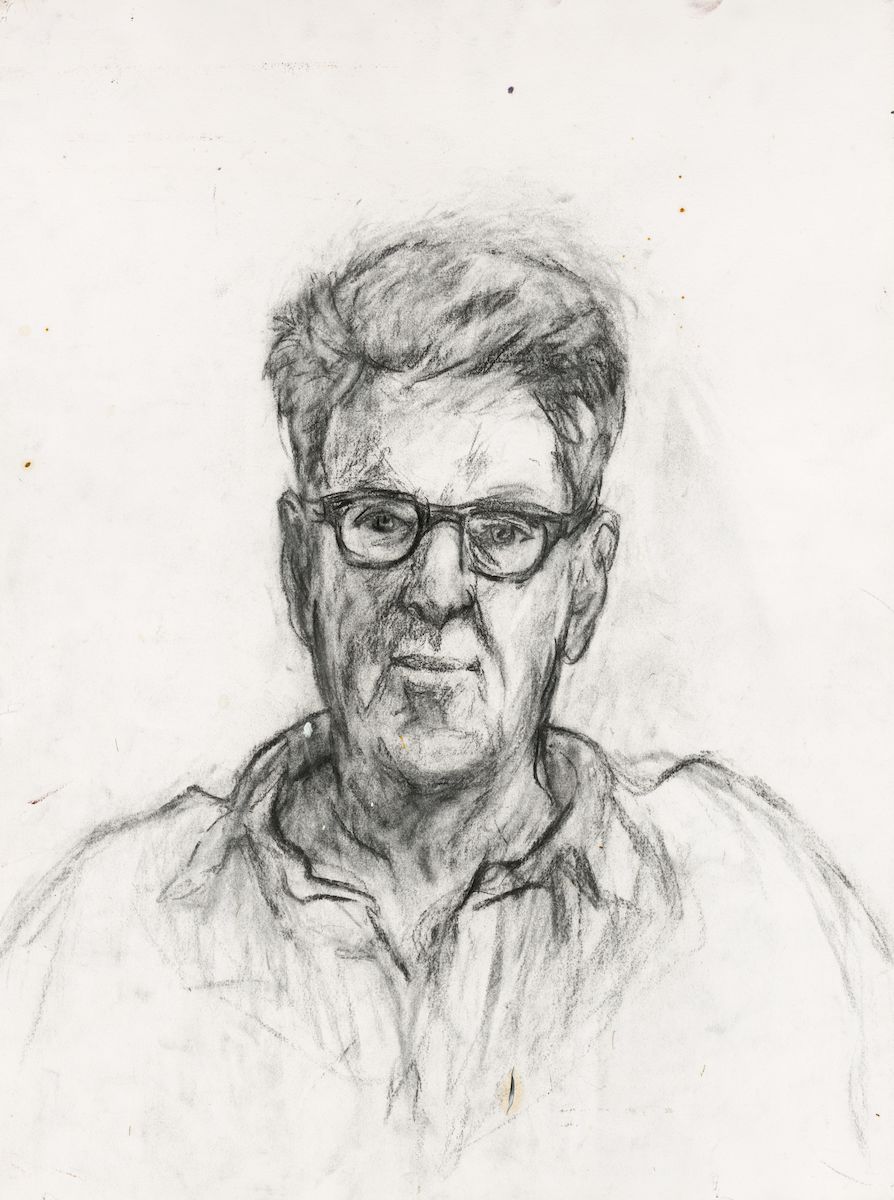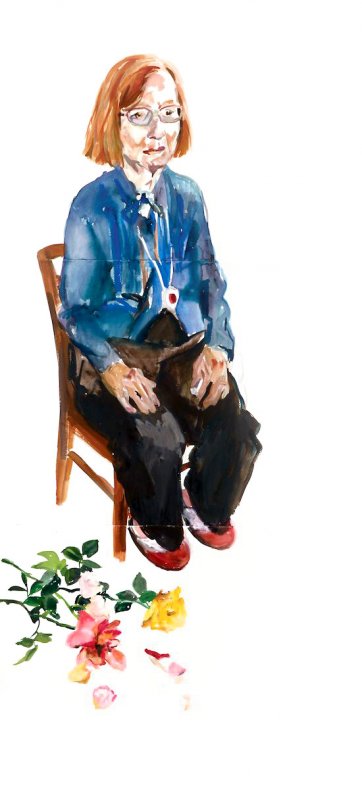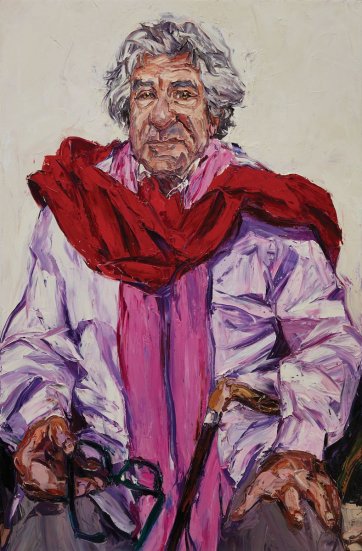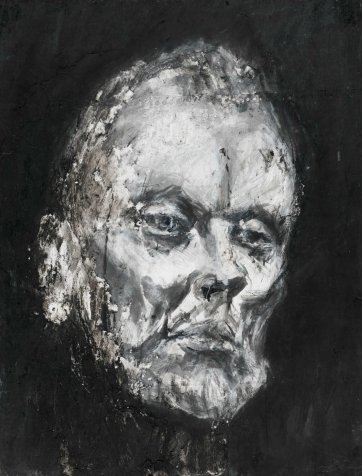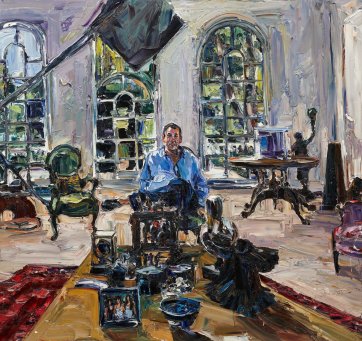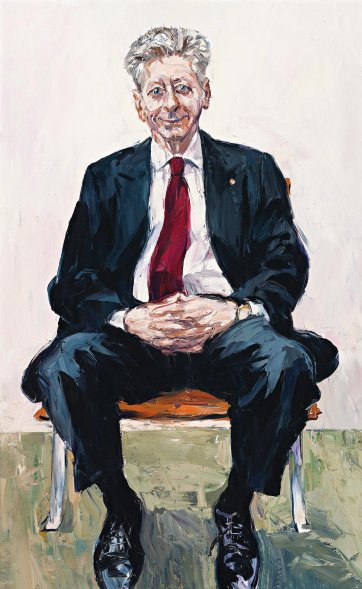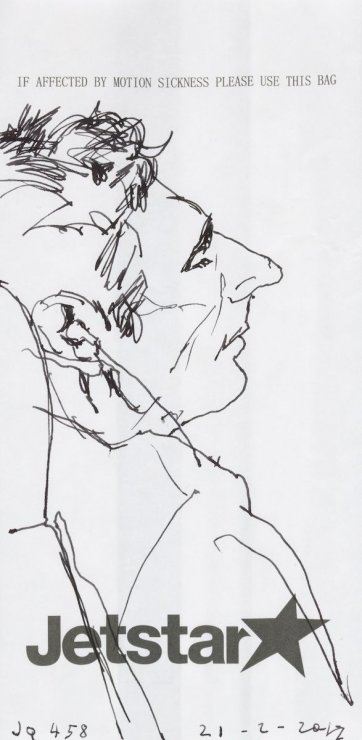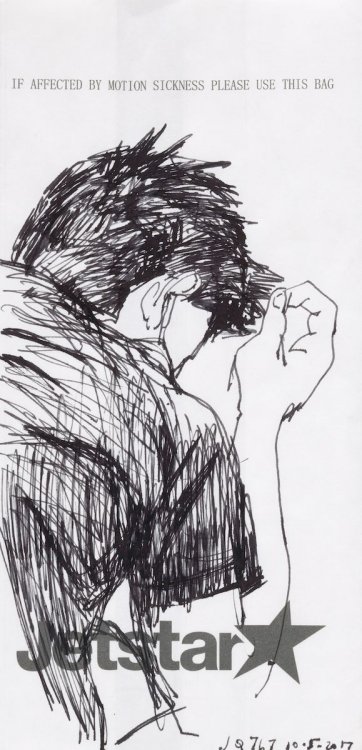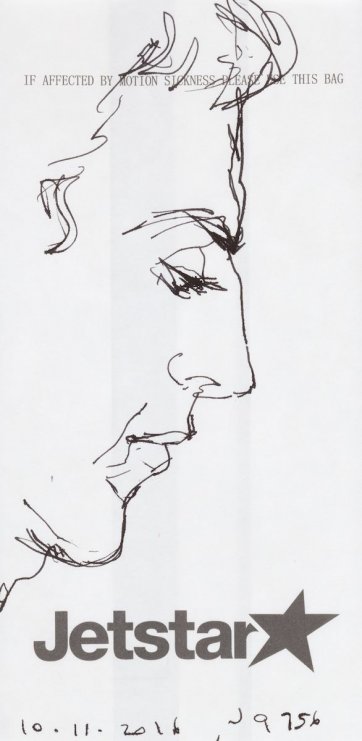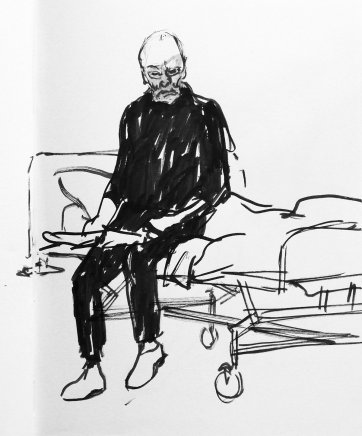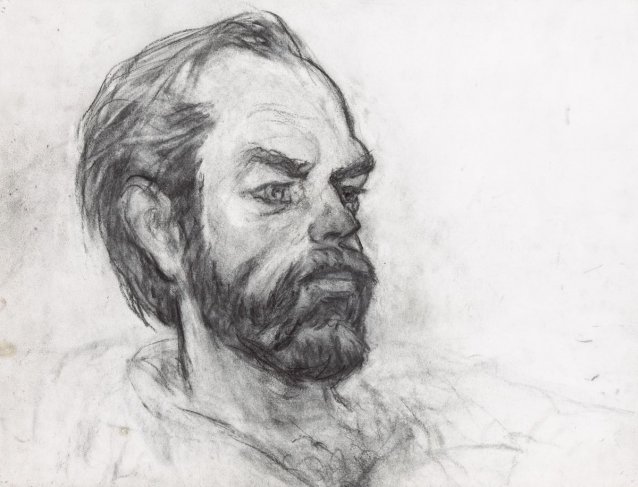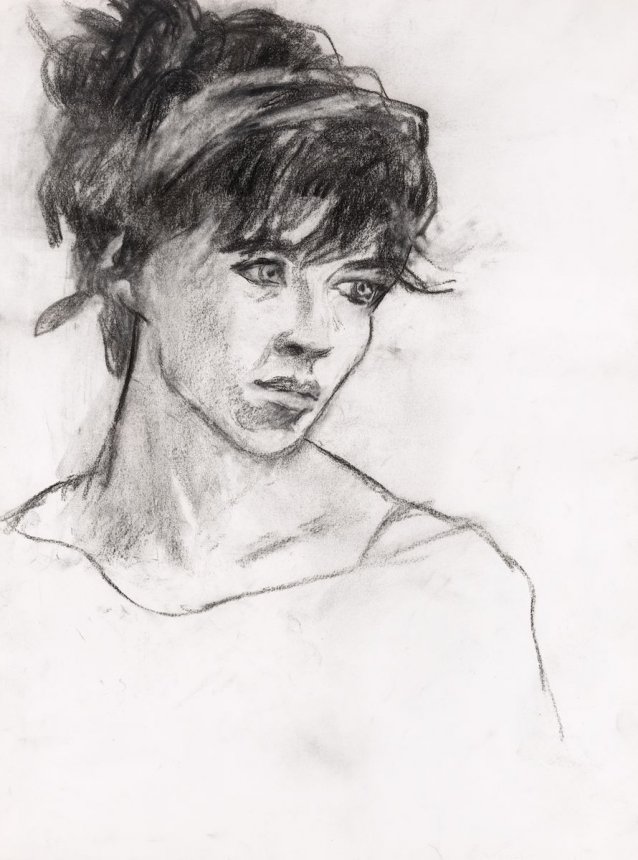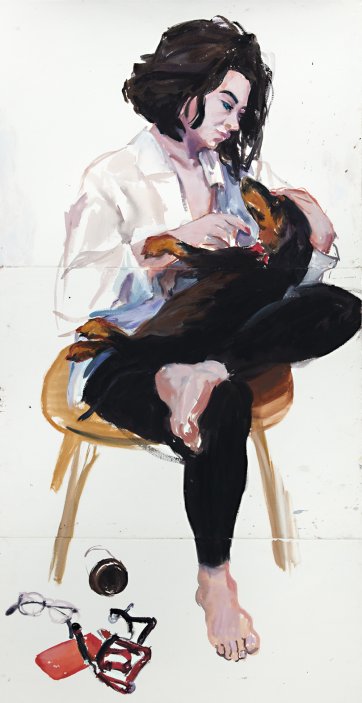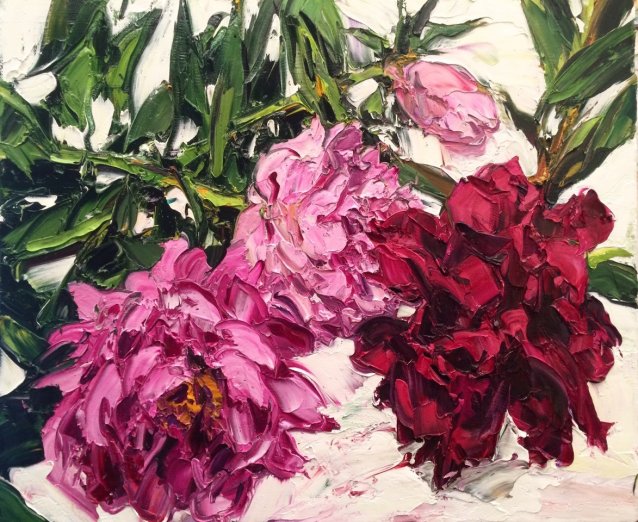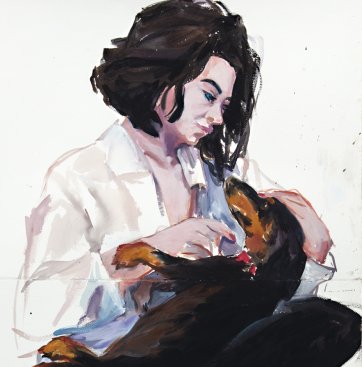Years ago, Nicholas Harding embarked on what turned out to be his most refractory portrait – an oil painting of the writer David Marr. The only traces of Harding’s prolonged effort to represent Marr are a handful of drawings in his studio. In pencil, the handsome humanist faces Harding frankly, with a good-humoured, patient expression, his firm, clean lips set in a pleasant line. But the longer Harding worked on Marr’s face in oils, the prissier it became. Having scraped the first portrait off, he threw a second in the bin. He entered another in the Archibald Prize, kept it back from the Salon des Refusés to enter it in the Moran, and destroyed it when it was returned to his studio. The failures accumulated to a point at which Marr blamed his face. Harding, though, trusts that one day the oil portrait will materialise.
Through thick and thin
by Dr Sarah Engledow, 19 December 2017
Nicholas Harding’s industrious, as well as patient and professional. His body of work is copious, and comprises great variety in medium and mood. The figure of Edie Watkins is meek; that of Peter Weiss is commanding. Weiss’ portrait glows in peony-pink, amaranth and crimson oils; John Bell’s is all black, white and grey. The covert, hasty sketches of unknown air travellers are distinct from the direct and careful drawings of famous men and women.
In his cluttered portrait with its watery interior light, John Feitelson seems small; in his clean, hot and stark portrait, its setting the open ocean, Robert Drewe looms large. Drewe looks like a strong man who’s been hurt. By contrast, sitting on a modernist chair in the artist’s Sydney studio, William Cowan, smartly suited, his black shoes gleaming, emanates energy and affability.
In Harding’s studio, upstairs from the spattered scene of his painting, are many bound sketchbooks and loose drawings. Uniquely, amongst them are scores of drawings on airline refuse bags that speak volumes of the alternate cosiness, tedium and exasperation of plane travel. A boy dozes with his chin on his chest. A man with a great prow of a nose is lost in a symphony or podcast, while a young woman, her hair scraped back, pincers her phone to watch a video.
A flight attendant, ponytail sleek and neckline demure, plies her trolley with downcast eyes. We imagine the passengers across the aisle from the artist, oblivious of his furtive pen. The portrait with the closest perspective is one of Harding’s 24-year-old son, Sam, in fine profile. His father’s been drawing him since he was born.
Harding was a lean youth with a talent for caricature when he met Sam’s mother, Lynne Watkins, on the Clarence coast of northern New South Wales in the early 1970s. Then, she was a tanned teenager with long golden hair. Now, her hair and clothes inner-city art-world black, her skin pale, her nails red, she’s Harding’s business manager, art critic and companion, his rock and his muse. They travel together by car, train or air to wherever he’s become obsessed with the landscape or the prospect of visiting a gallery. He carries a sketchbook. Often, in the midst of drawing commuters, dogs, flowers, café patrons or the features of their accommodation, he’ll throw down a quick impression of Lynne.
Harding’s interest in theatre dates to his boyhood. He was in the audience for the first productions of the Bell Shakespeare Company in 1991, and he won the Archibald for an oil portrait of John Bell in 2001. He’d made the final with a portrait of Bell the year before, too; in fact, portraits of Bell had been fomenting in his imagination for a decade, on and off. The ink, charcoal and conté portrait of Bell is dated 1998-2001, meaning that he worked on it all that time. Yet Harding hasn’t finished with the actor. Decades after sweltering through The Merchant of Venice in a tent at the Sydney Showground, at the beginning of August 2017 he was drawing Bell in his pyjama costume, rehearsing The Father at the Sydney Theatre Company. In recent years, Harding’s drawn many of the STC’s productions in rehearsal and performance, including Waiting for Godot, Macbeth, Cyrano de Bergerac and Endgame.
Watching stage productions, Harding’s alert to passages of high drama, grand gesture, striking effects of colour and light; but also to transitory moments of self-doubt, wistfulness, vigour and frailty. Among his repeated subjects, it’s Hugo Weaving, above all, who’s appeared in multifarious situations and moods.
The actor and the artist met years ago, through their respective children. In 2011 Harding started on a portrait of Weaving. The first sitting, at the actor’s Sydney home, felt artificial; Weaving was rather self-conscious, and Harding was disconcerted by his having shaved for a new role. By the second, Weaving was more at ease and bearded anew. In the tedium of sitting, his eyes roved – and Harding found the ruminative, unguarded expression he wanted to paint. Later, in the studio, he tinkered with the composition of the portrait, obliterating some elements and adding others to indicate the famous man’s love of family and home.
In 2015 Harding, Weaving, their partners and other friends holidayed in Sicily, where Weaving happily roamed in anonymity, gathering flowers. Among the huge landscapes and luscious floral paintings that resulted from Harding’s time abroad was Cannamara still life (Hugo’s wildflowers). For a no-nonsense man, Harding’s exceptionally responsive to flowers. Many pleasant scenes of his early life in England played out in his grandparents’ garden. Decades later, his mother-in-law, Edie Watkins, planted out a block in Wooli, northeast New South Wales, growing many of the thousands of flowers he’s painted over the past fifteen years: roses, orchids, kangaroo paws, banksia, frangipani, paper daisies, swamp lilies and glory lilies. Octogenarian Edie triggered a significant shift in the challenging portraits in gouache (a type of watercolour) that Harding started making in Paris in 2013. As was his custom, he’d painted her over two sheets, but her figure ended at the ankles, which is undesirable in a portrait. On a third sheet, though, all he had to add were Edie’s fleece-lined scuffs. Compositionally, that was disagreeable. For balance, then, he tossed some cut roses on the floor beside her and painted them. He found he liked the scale and proportions of the piece, and the way Edie’s roses suggested her personality and interests. He carried elements of this picture through a subsequent series over 2015-2016.
Year after year, the period around the Archibald-Wynne-Sulman prizes is a galling one for many Australian artists. Harding’s been an Archibald finalist 17 times; hurtfully, there have been years when his entries haven’t been hung. Yet getting portraits into shows like the Archibald and the Doug Moran National Portrait Prize has two advantages: it encourages enquiries about his availability for commissions, and gives him a chance to meet people he admires. Harding’s put himself in a position where he can approach pretty much anyone he’s interested in painting, now, and often – though not always – they’ll agree to sit.
Harding met the brilliant singer Megan Washington through a biennial event at the Art Gallery of New South Wales called Art of Music. Invited contributors create a work inspired by a song by an Australian or New Zealand performer, which is auctioned to raise funds for therapeutic music programs. Harding made a painting inspired by Washington’s song ‘Underground’, which she sang, enchantingly, at the glamorous fundraiser. Soon, they were discussing a portrait; and as soon as she had a free day she came to the studio to sit for him. Remarkably, the delicate charcoal drawings he made of Washington succeed in conveying the intense blue of her eyes. He’s painted her in gouache, too; but he’s intent on an oil portrait when their schedules align.
Edmund Capon, former director of the Art Gallery of New South Wales (and himself the subject of a portrait by Harding) introduced the artist to Peter Weiss. From the mid-1970s to 1997 Weiss was well-known as the head of a major Australian fashion business, but originally he trained very seriously as a cellist. Since his glad departure from the rag trade he’s directed his energy and financial resources at facilities for music and art in Sydney. Early in 2016, Harding took his paper and gouache tubes to Weiss’ house and, in his customary intense flurry, made a full-length sketch of him. Weiss recalls being amazed at its vigour, as well as the facility with which it was achieved. He was excited about the portrait to come; but found the self he encountered on canvas comparatively subdued. The painted Weiss gives off the man’s habit of command – but a little ruefulness, too.
The portrait of Weiss borrows from the palette of Harding’s glorious oil paintings of peonies. There’s something about it that evokes a historical portrait of a European nobleman; the red wrap is the colour of the cape of Raphael’s Pope Julius ii from 1511, and the colour and folds of the cloth recall the ‘turban’ in Van Eyck’s Portrait of a Man from 1433. Compositionally, it’s strong, with a sturdy cross brace formed by the rosy scarf hanging straight, and the crimson tossed horizontally. With his sceptical expression mixed with both a tinge of hope and the threat of starting up with a roar, the painted Weiss has the visage of an old king, tired of contenders and conspirators. Indeed, perhaps we can put his air of vulnerability down to Harding’s attentiveness to minimal gestures and momentary glances that round out a character – Lear, for example – on stage.
Harding’s mostly painted portraits for his own edification, and his subjects have been his friends and their friends, people from the Sydney art, theatre and music scenes. The picture of William Cowan, however, was commissioned by Trinity College at the University of Melbourne, on the board of which Cowan served from 1987 to 2013.
Oddly enough, this painting of an engineer who became a career company director and now advises senior executives is one of Harding’s most arresting and convincing portraits.
By Harding’s standards, the portrait of Cowan isn’t a colourful picture, but the artist enjoyed the challenge of painting only the second suit of his entire career. The neutral backdrop is tinted with the red of Cowan’s tie; similarly, there’s a suspicion of red in Cowan’s white shirt. This helps a great deal in pulling the work together. As an artist who paints a lot of bare feet, feet in sensible sandals and Sydney-style loafers, Harding’s particularly pleased with the job he did on Cowan’s shiny business shoes. Although shoes in a pair are the same, they can’t be painted the same, because of the way the light hits them: the highlights on the shoe on our left are light grey, those on the shoe on the right, violet. In contrast to Weiss’ feet, which moved off the canvas because of the way the figure evolved, Cowan’s feet were never intended to appear entire. The missing toe sections draw the eye out to the space beyond in a tactic contributing to the portrait’s dynamism. Cowan looks benign and zesty; we feel he’s about to jump up and pursue a positive initiative.
Robert Drewe doesn’t look so effective in Harding’s great portrait from 2006, and it’s not just because he’s bared to the elements. His expression is wounded and wary.
Robert Drewe, author of The Bodysurfers, The Rip, The Drowner and The Shark Net, was just the man to open a group exhibition called The Sea for Harding’s long-term art dealer, Rex Irwin, in 2005. Soon after, Harding contacted him about the possibility of a portrait. That summer, Harding began a series of drawings of Drewe on the beach around Byron Bay. The author found it discomfiting to be studied at his leisure. The painter was alternately pleased and depressed by his own efforts. Several attempts were scrubbed out. The holiday season ended. After a break, the sessions resumed. During this time, Harding looked up from his work to see that Drewe had lost focus, for a second, on the portrait process. Just as he did for the portrait of Bell, and, years later, for that of Weiss, Harding seized on a ‘look’ of which his sitter was unaware – one that ran counter to his jovial public demeanour.
Only having conceived of Drewe’s face did Harding decide on his figure. That came to him as he was bobbing in the sea, lazily attending to the different tempos of wavelets and ripples against his chest, squinting at the blending blues of water and sky. He went back to Sydney and painted Drewe’s body convincingly submerged, achieving that difficult effect by painting the water itself in smooth, curving strokes of green, white and pinkish light brown. It’s a cheering fact that the actual Robert Drewe’s much happier now than he was, unbeknownst to Harding, 11 years ago; but the man in Harding’s perceptive and intelligent portrait won’t ever have any confidence in his capacity to recover from the situation he was in when he was painted. We meet his eyes, and a wave of humaneness drags at us.
The differences between the portraits of Robert Drewe and John Feitelson exemplify the contrasts that occur throughout Harding’s work. One man’s represented outside in the glare, the other inside in shadowy, wobbly light. Drewe’s unclothed and Feitelson wears jeans and boat shoes. Drewe has nothing and Feitelson’s surrounded by his chattels. Drewe’s head occupies fully one quarter of the canvas, and looking into the extraordinary painted mess of his eyes we come close to swallowing the notion that a painted portrait can reveal something of its subject’s psyche or ‘soul’. Feitelson’s face is occluded and occupies about one two-hundredth of the picture. His soul is not on view.
John Feitelson, a property investor and art collector, bought a couple of big drawings by Harding in the early 1990s and proceeded to commission a portrait from Harding through his dealer, Rex Irwin. At the time, Feitelson and his family were living in a pocket mansion created by the architect F Glynn Gilling in the first half of the twentieth century. By the time Harding came to the house to start work on the portrait, Feitelson’s wife Roslyn had been diagnosed with cancer. Harding set down some drawings and went away to complete the portrait in the studio. She did not live to see it. The empty green chair is symbolic of her; but in addition, Feitelson asked the artist to add a photograph of Roslyn and their twin daughters to the objects on the low table. When he sold the Gilling house, the portrait went into storage. Looking at it after some years, Feitelson was struck by the eloquence with which it evoked that time and place.
Feitelson appears very much alone in his magnificent reception room. In ranks before him, his art pieces seem like a defensive bulwark, and the sheer accumulation of paint in the picture contributes to the inaccessibility of his small figure. Feitelson particularly likes the way Harding captured the old glass in the French windows of his home, which, he remembers, had a refractive, slightly distorting character. To achieve the effect of light coming through the uneven panes, Harding went all-out with colour. By way of the greens in the window arches and the violet on the walls he created an atmosphere like that of a submarine cave, with wavering, muted light seeping in. We look ‘through’ the right hand window at a tree trunk and a piece of white concrete balustrade, a feature right at home in one of Gilling’s distinctively eclectic, Hollywood-Spanish-style architectural follies.
Beached (Yuraygir self portrait) was the People’s Choice for the University of Queensland Art Museum’s National Self Portrait Prize for 2015 – a huge year for Harding, who portrayed himself prostrated in the work. The painting’s instantly recognisable as a Harding, for he’s painted scores of scenes of people on hot beaches and vegetation of the north coast, but it’s a bravura, assertive piece synthesising elements of his accomplishment over decades. The background comprises the kind of north coast scrub that Harding’s made his own, in life and in paint. That scrappy bush really is hard to assimilate, visually. In the painting, further, it’s a metaphor for middle age: it’s very difficult to get through, there are dead sections, tangled parts, bits that have dropped off, bits that are propped up, there’s a mat of weedy material on the creeping move. The artist’s built the vegetation up in stunningly lavish, luscious paint; branches and sticks in the upper right quadrant are rendered in creamy chocolate and caramel oils, sand in the lower right in unctuous fudgy vanilla. Protective paraphernalia of the adult beachgoer clutters the foreground with rich colour. We infer the man’s come in from a long swim; he’s relishing the illicit pleasure of broiling in the sun. The string lies drying upon his bunched-up trunks. His feet splay like those of Manet’s Dead toreador flat on the sand of the bullring. His thin body with its sunken belly and prominent ribs recall Holbein’s Body of the dead Christ in the tomb. But still, his blue eye blazes. His motionless posing figure looks furtively at himself, painting his own portrait. It’s the perfect trope for Harding whose work is so intimately bound up with his being in the world; who’s a kind of optimistic existentialist, describing his development as a portraitist as a process of finding out how ‘we occupy a mortal sack of blood, muscle and bone’.
8 portraits view all
Megan Washington and Artie, 2016 by Nicholas Harding (detail)
Collection of Nicholas Harding and Lynne Watkins.
Related people
Related information
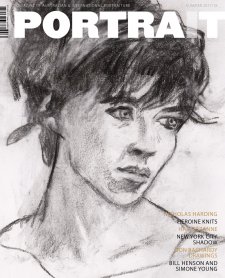
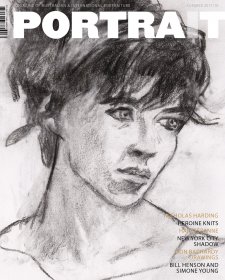
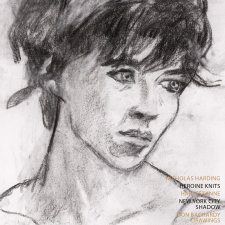
Portrait 58, Summer 2017-18
Magazine
Paul Cézanne, Bill Henson and Simone Young, Australian cinema’s iconic women, and feminist portraits by Kate Just.

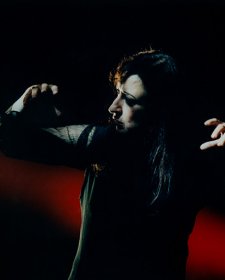

Conduct becoming
Magazine article by Penelope Grist
Penelope Grist speaks to Bill Henson and Simone Young to discover the origins of the artist’s stunning photographic triptych.



Hail Cézanne
Magazine article by John Elderfield
John Elderfield lauds the portraiture of Paul Cézanne, the artist described by both Matisse and Picasso as ‘the father of us all’.
